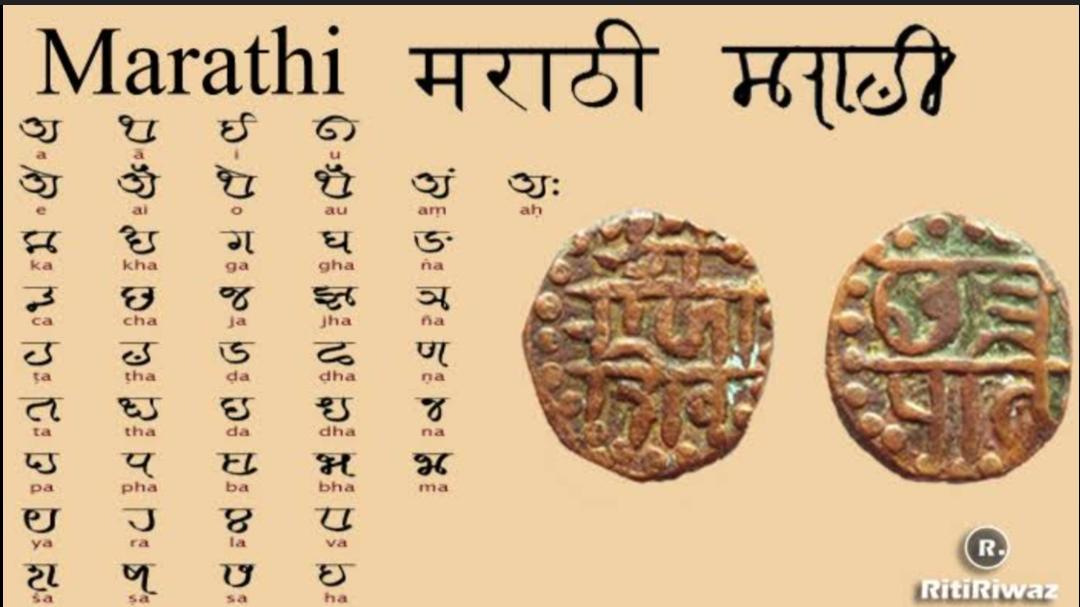

Marathi is an Indo-Aryan language predominantly spoken by Marathi people in the Indian state of Maharashtra. It is the official language of Maharashtra, and additional official language in the state of Goa. It is one of the 22 scheduled languages of India, with 83 million speakers as of 2011. Marathi ranks 11th in the list of languages with most native speakers in the world. Marathi has the third largest number of native speakers in India, after Hindi and Bengali. The language has some of the oldest literature of all modern Indian languages. The major dialects of Marathi are Standard Marathi and the Varhadi dialect.
Marathi distinguishes inclusive and exclusive forms of 'we' and possesses a three-way gender system, that features the neuter in addition to the masculine and the feminine. In its phonology, it contrasts apico-alveolar with alveopalatal affricates and alveolar with retroflex laterals (Marathi letters ? and ? respectively).
Indian languages, including Marathi, that belong to the Indo-Aryan language family are derived from early forms of Prakrit. Marathi is one of several languages that further descend from Maharashtri Prakrit. Further changes led to the formation of Jain Apabhra?sa followed by Old Marathi. However, this is challenged by Bloch (1970), who states that Apabhra?sa was formed after Marathi had already separated from the Middle Indian dialect.
The earliest example of Maharashtri as a separate language dates to approximately 1st century BCE: a stone inscription found in a cave at Naneghat, Junnar in Pune district had been written in Maharashtri using Brahmi script. A committee appointed by the Maharashtra State Government to get the Classical status for Marathi has claimed that Marathi existed at least 1,500 - 2,000 years ago alongside Sanskrit as a sister language. Marathi, a derivative of Maharashtri Prakrit language, is probably first attested in a 739 CE copper-plate inscription found in Satara. Several inscriptions dated to the second half of the 11th century feature Marathi, which is usually appended to Sanskrit or Kannada in these inscriptions. The earliest Marathi-only inscriptions are the ones issued during the Shilahara rule, including a c. 1012 CE stone inscription from Akshi taluka of Raigad district, and a 1060 or 1086 CE copper-plate inscription from Dive that records a land grant (agrahara) to a Brahmin.
A 2-line 1118 CE Marathi inscription at Shravanabelagola records a grant by the Hoysalas. These inscriptions suggest that Marathi was a standard written language by the 12th century. However, there is no record of any literature produced in Marathi until the late 13th century.After Indian independence, Marathi was accorded the status of a scheduled language on the national level. In 1956, the then Bombay state was reorganized, which brought most Marathi and Gujarati speaking areas under one state. Further re-organization of the Bombay state on 1 May 1960, created the Marathi speaking Maharashtra and Gujarati speaking Gujarat state respectively. With state and cultural protection, Marathi made great strides by the 1990s. A literary event called Akhil Bharatiya Marathi Sahitya Sammelan (All-India Marathi Literature Meet) is held every year. In addition, the Akhil Bharatiya Marathi Natya Sammelan (All-India Marathi Theatre Convention) is also held annually. Both events are very popular among Marathi speakers.
Notable works in Marathi in the latter half of 20th century include Khandekar's Yayati, which won him the Jnanpith Award. Also Vijay Tendulkar's plays in Marathi have earned him a reputation beyond Maharashtra. P.L. Deshpande (popularly known as PuLa), Vishnu Vaman Shirwadkar, P.K. Atre, Prabodhankar Thackeray and Vishwas Patil are known for their writings in Marathi in the fields of drama, comedy and social commentary. Bashir Momin Kavathekar wrote Lavani's and folk songs for Tamasha artists.
In 1958 the term "Dalit literature" was used for the first time, when the first conference of Maharashtra Dalit Sahitya Sangha (Maharashtra Dalit Literature Society) was held at Mumbai, a movement inspired by 19th century social reformer, Jyotiba Phule and eminent dalit leader, Dr. Bhimrao Ambedkar. Baburao Bagul (1930�2008) was a pioneer of Dalit writings in Marathi. His first collection of stories, Jevha Mi Jat Chorali (?????? ?? ??? ?????, "When I Stole My Caste"), published in 1963, created a stir in Marathi literature with its passionate depiction of a cruel society and thus brought in new momentum to Dalit literature in Marathi. Gradually with other writers like Namdeo Dhasal (who founded Dalit Panther), these Dalit writings paved way for the strengthening of Dalit movement. Notable Dalit authors writing in Marathi include Arun Kamble, Shantabai Kamble, Raja Dhale, Namdev Dhasal, Daya Pawar, Annabhau Sathe, Laxman Mane, Laxman Gaikwad, Sharankumar Limbale, Bhau Panchbhai, Kishor Shantabai Kale, Narendra Jadhav, Keshav Meshram, Urmila Pawar, Vinay Dharwadkar, Gangadhar Pantawane, Kumud Pawde and Jyoti Lanjewar.
In recent decades there has been a trend among Marathi speaking parents of all social classes in major urban areas of sending their children to English medium schools. There is some concern that this may lead to the marginalization of the language.